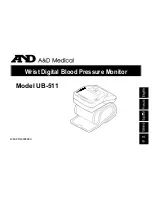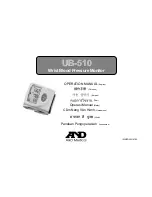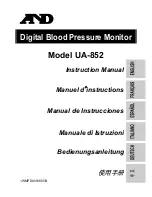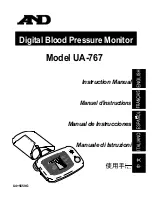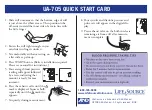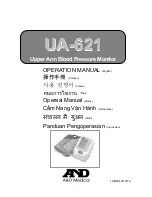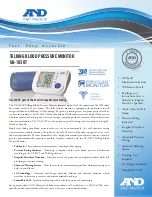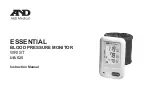
1
INTRODUCTION
Your blood pressure monitor is an automatic digital blood pressure measuring device
for use on the wrist. It enables very fast and reliable measurement of the systolic and
diastolic blood pressure as well as the pulse frequency by way of the oscillometric
method of measuring. Thanks to the large LCD display of BP model #80201 both
operational status and cuff pressure are visible for the entire duration of the measure-
ment. Before using, please read through this instruction manual carefully and then
keep it in a safe place. For further questions on the subject of blood pressure and its
measurement, please consult your doctor.
Important information about self-measurement
• Do not forget: self-measurement means control, not diagnosis or treatment.
Unusual values should be discussed with your doctor. Under no circumstances
should you alter the dosages of any drugs prescribed by your doctor.
• The pulse display is not suitable for checking the frequency of heart pacemakers.
• In cases of cardiac irregularity (arrhythmia), measurements made with this instru-
ment should only be evaluated after consultation with the doctor.
Electromagnetic interference:
The device contains sensitive electronic components (microcomputer). Therefore,
avoid strong electrical or electromagnetic fields in the direct vicinity of the device
(e.g. cellular phones, microwave ovens). These can lead to temporary impairment
of the measuring accuracy.
IMPORTANT INFORMATION ON BLOOD PRESSURE AND
ITS MEASUREMENT
How does high/low blood pressure arise?
Your blood pressure level is deter-
mined in the circulatory center of your brain. Your nervous system allows your body to
adapt or alter blood pressure in response to different situations. Your body alters your
pulse and the width of blood vessels through changes in muscles in the walls of
blood vessels. Your blood pressure reading is highest when your heart pumps or ejects
blood. This stage is called your systolic blood pressure. Your blood pressure is lowest
when the heart rests(in-between beats).This is called your diastolic blood pressure. It
is critical to maintain blood pressure values within a "normal" range(s) in order to
prevent particular diseases.
Which values are normal?
Blood pressure is too high if at rest, the systolic blood
pressure is over 140mmHg and/or the diastolic pressure is above 90mmHg. In this
case, please consult your doctor. Long-term values at this level can endanger your
health due to the associated advancing damage to the blood vessels in your body.
With blood pressure values that are too low, i.e. systolic values under 105 mmHg
and/or diastolic values under 60 mmHg, you should consult your doctor. Even with
normal blood pressure values, a regular self-check with your blood pressure monitor is
recommended. In this way you can detect possible changes in your values early and
react appropriately. If you are undergoing medical treatment to control your blood
pressure, please keep a record of the level of your blood pressure by carrying out reg-
ular self-measurements at specific times of the day. Show these values to your doctor.
Never use the results of your measurements to alter independently the
drug doses prescribed by your doctor.
Further information
• If your values are mostly standard under resting conditions but exceptionally high
under conditions of physical or psychological stress, it is possible that you are
suffering from “labile hypertension” (frequently changing levels of elevated blood
pressure). Please consult your doctor if you suspect that this might be the case.
What can be done, if high/low values are obtained?
a) Please consult your doctor.
b) Increased blood pressure values (various forms of hypertension) are associated long
and medium term with considerable risks to health. This concerns the arterial blood
vessels of your body, which are endangered due to constriction caused by deposits in
the vessel walls (arteriosclerosis). A deficient supply of blood to important organs
(heart, brain, muscles) can be the result. Furthermore, with long-term continuously
increased blood-pressure values, the heart will become structurally damaged.
c) There are many different causes of the appearance of high blood pressure. We dif-
ferentiate between the common primary (essential) hypertension, and secondary
hypertension. The latter group can be ascribed to specific organic malfunctions. Please
consult your doctor for information about the possible origins of your own increased
blood pressure values.
d) There are steps you can take, not only for reducing a medically established high
blood pressure, but also for prevention. These steps must be a part of your general
way of life:
Eating habits
• Strive for a normal weight corresponding to your age
• Avoid excessive consumption of salt
• Avoid fatty foods
Previous illnesses
• Follow consistently any medical instructions for treating previous illness such as:
• Diabetes (Diabetes mellitus)
• Fat metabolism disorder
• Gout
Habits
• Give up smoking completely.
• Drink only moderate amounts of alcohol.
• Restrict your caffeine consumption (Coffee).
Physical constitution
• After a preliminary medical examination, do regular exercise.
• Choose sports which require stamina and avoid those which require strength.
• Avoid reaching the limit of your performance.
• With previous illnesses and/or an age of over 40 years, please consult your doctor
before beginning your sporting activities. He will advise you regarding the type and
extent of types of sport that are possible for you.
COMPONENTS OF YOUR BLOOD PRESSURE MONITOR
The illustration shows the Timex Wrist blood pressure monitor, consisting of:
Blood Pressure
Monitor
Battery Cover
Digital Display
Memory Button
On/Off Button
Automatic Wrist
Model# 80201





